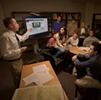USC Shoah Foundation Institute Announces Stipends for USC Faculty

The USC Shoah Foundation Institute for Visual History and Education announces a program of summer stipends to assist members of the faculty in integrating the Institute’s interviews into existing courses or to assist in the creation of new courses.
The Institute holds 52,000 video testimonies of survivors and other eyewitnesses to the Holocaust. The interviews were taken in 32 languages and in 56 countries. They encompass the experience not only of Jewish survivors, but of others targeted by the Nazis, as well as liberators, rescuers, and war crimes trials participants. Their subject matter ranges well beyond the Holocaust to include the history and culture of the countries of the interviewees’ birth before the Holocaust, and the history and culture of the countries to which they emigrated after it. The interviews average 2½ hours in length and contain great breadth of interest for many disciplines.
The program of summer stipends (up to 4 will be awarded for the summer of 2008) will provide direct support to faculty members wishing to use the archive in their teaching, as well as expenses associated with the creation of teaching materials for use with USC undergraduates. The staff of the Institute will support the work of faculty members receiving the stipends, who will be designated Fellows of the USC Shoah Foundation Institute. The Institute anticipates an ongoing relationship with each class of Fellows that will reach beyond the summer during which the work is done.
Stipends will be in the amount of $5,000 plus up to $1,000 in associated expenses. The Institute wishes to emphasize that there are no restrictions with respect to the disciplinary approach or methodology of Fellows. The goal of this program is to offer faculty members the opportunity to use the more than 100,000 hours of video in the Institute’s archive in whatever fashion and using whatever methods they deem appropriate. The only restriction is that Institute video must be incorporated into existing courses or used to create new ones.